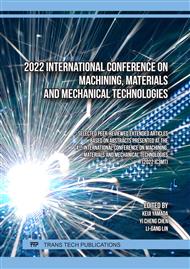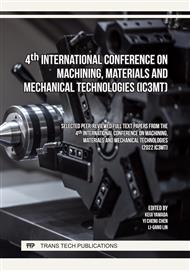[1]
Y. Liu and H. Yu, A survey of underactuated mechanical systems, IET Control Theory and Applications, Vol. 7, Issue 7, pp.921-935, 2013.
DOI: 10.1049/iet-cta.2012.0505
Google Scholar
[2]
L. U. Odhner, R. R. Ma and A. M. Dollar, Precision Grasping and Manipulation of Small Objects from Flat Surfaces using Underactuated Fingers, IEEE International Conference on Robotics and Automation, RiverCentre, Saint Paul, Minnesota, USA, 2012.
DOI: 10.1109/icra.2012.6225211
Google Scholar
[3]
A. Niikura, H. Nabae, G. Endo, M. Gunji, K. Mori, R. Niiyama and K. Suzumori, Giraffe Neck Robot: First Step Toward a Powerful and Flexible Robot Prototyping Based on Giraffe Anatomy, IEEE Robotics and Automation Letters, Vol. 7, No. 2, 2022.
DOI: 10.1109/lra.2022.3146611
Google Scholar
[4]
D. J. Block, Mechanical Design and Control of the Pendubot, Doctor's thesis, University of Illinois, 1996.
Google Scholar
[5]
I. Fantoni and R. Lozano, Non-linear Control for Underactuated Mechanical Systems, pp.53-72, 2002.
Google Scholar
[6]
M. Gulan, M. Salaj, M. Abdollahpouri and B. Rohal-Ilkiv, Real-time MHE-based nonlinear MPC of a Penbubot system, IFAC-PaperOnLine, Vol. 48, No. 23, pp.422-427, 2015.
DOI: 10.1109/ines.2015.7329732
Google Scholar
[7]
Q. Wei, W.P. Dayawansa and W.S. Levine, Nonlinear controller for an inverted pendulum having restricted travel, Automatica, Vol. 31, No. 6, p.841–850, 1995.
DOI: 10.1016/0005-1098(94)00138-9
Google Scholar
[8]
R. Tatsumi and K. Takaba, Swing-up Control of an Inverted Pendulum with Limited Pivot Travel, ICROS-SICE International Joint Conference 2009, p.3061–3065, 2009.
Google Scholar
[9]
I. Matsumoto and K. Yoshida, Swing-up and Stabilizing Control of the Acrobot, Transactions of the Institute of Systems, Control and Information Engineers, Vol. 17, No. 1, pp.17-25, 2004 (in Japanese).
DOI: 10.5687/iscie.17.17
Google Scholar
[10]
D. Kinoshita, K. Yoshida and I. Matsumoto, Stabilizing control for an inverted pendulum with restricted travel, Transactions of the Society of Instrument and Control Engineers, Vol. 53, No. 7, pp.408-415, 2017 (in Japanese).
DOI: 10.9746/sicetr.53.408
Google Scholar
[11]
K. Yoshida and I. Matsumoto, Stabilizing control for an inverted pendulum with restricted travel, American Control Conference, pp.543-548, 2009.
DOI: 10.1109/acc.2009.5159919
Google Scholar



